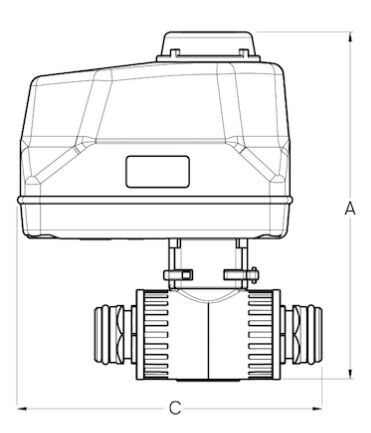Solutions for Motor Overheating of Electric Ball Control Valve
On this page
During actual use, electric ball control valves may experience operational issues due to improper handling or inherent valve problems, with motor overheating being a common issue. Many customers have encountered this problem, which can be resolved within minutes with appropriate measures. However, if the measures are improper, it may directly lead to motor damage, affecting the overall normal operation of the electric ball control valve.
Motor overheating is a common phenomenon during normal operation, especially in situations where the valve is frequently switched on and off. Slight heating is normal, but if the motor temperature rises significantly and does not decrease after the valve is closed, it indicates a problem that needs to be promptly identified and resolved.
The motor of an electric ball control valve may experience a temperature increase due to insufficient heat dissipation during long periods of continuous operation. This is particularly the case in applications where the valve is frequently switched, leading to a high load on the motor and potentially inadequate cooling capacity. Overheating in such situations is a common occurrence. When motor overheating is detected, it is necessary to use an electric pen to test the motor current to confirm whether the motor is still working, to determine if the overheating is due to continuous operation.
The control system of an electric ball control valve typically includes electronic and mechanical limit devices. The electronic limit device is responsible for controlling the start and stop of the motor when the valve is switched, while the mechanical limit serves as an auxiliary safeguard. If the electronic limit system fails, the motor may continue to operate even after the valve has reached its switching position, causing the motor to overheat. In this case, it is necessary to check whether the electronic limit switch is working correctly.
Debris in the pipeline, such as weeds, sticks, or other foreign objects, may obstruct the normal operation of the valve. If these objects jam the valve plate, preventing the valve from fully opening or closing, the electronic limit system will not detect the actual position of the valve, leading to continuous motor operation. In this case, the pipeline should be inspected and any debris that may hinder valve operation should be removed to ensure the valve functions properly.
Under normal circumstances, the motor should stop working under the intervention of the electronic limit, with the mechanical limit serving as an auxiliary role. If the electronic limit system is faulty or improperly set, the valve may continue to operate near the mechanical limit, causing the motor to overheat. In this case, it is necessary to check the coordination between the mechanical limit device and the electronic limit device. Inspect whether the micro-switch block of the limit switch is slipping or deviating from the original adjusted position, and adjust it to the correct position to prevent the motor from overheating due to prolonged operation.
For the issue of motor overheating in electric ball control valves, the following measures can effectively restore the normal operation of the equipment and prevent further damage.
Inspect Motor Current: Firstly, use an electric pen to test if the motor is drawing current, confirming if the motor is active.
Clean Pipeline Debris: Inspect the pipeline for debris and remove any obstructions that might be jamming the valve plate.
Adjust Limit Switches: Access the control panel and verify the micro-switch for electronic limit engagement; ensure it is functioning without slippage or misalignment from its original set position. Correct any discrepancies to resolve the issue.
To preemptively address the overheating issue of the motor in electric ball control valves, the following preventive measures are recommended.
Routine Maintenance and Service: Conduct regular maintenance and servicing of the valve, including pipeline cleaning and limit switch checks, to maintain optimal operational status.
Proper Operation: Operators should adhere strictly to operational protocols to prevent overheating due to improper handling.
Cooling Devices Installation: In environments with frequent valve switching, consider installing cooling devices to enhance the motor's heat dissipation capability and prevent excessive temperature buildup.
While the overheating of electric ball control valve motors is a common issue, it can be swiftly remedied with accurate diagnosis and appropriate interventions. The key lies in promptly monitoring motor status, assuring the correct synchronization between electronic and mechanical limits, and keeping the pipeline free from debris. Only by doing so can the valve's normal function be guaranteed and the equipment's lifespan be extended. Consistent maintenance and proper operational practices are effective for preventing such issues, ensuring system stability and reliability.

